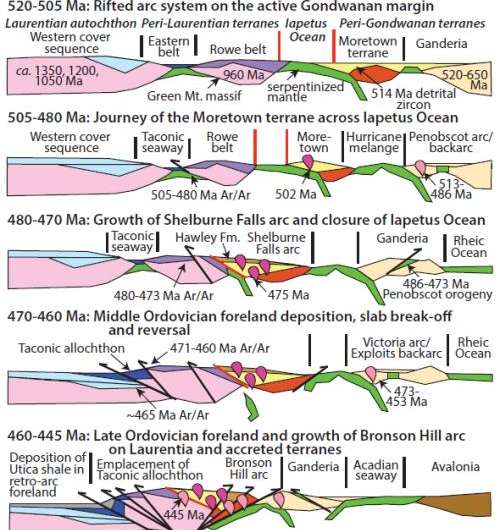Mountain-building and the end of an ancient ocean beneath modern New England

When and where did the ancient Iapetus Ocean suture (the most fundamental Appalachian structure) form? Is part of New England made up of ancient African-derived rocks? What is the Moretown terrane? This new Geology study by researchers from Harvard, Middlebury College, Boise State University, and Williams College finds new evidence for an earlier closing of the Iapetus that is farther west than previous studies have reported.
Mountain-building events, called "orogenies," in the northern U.S. Appalachia record the closure of the Iapetus Ocean, an ancient precursor to the Atlantic. The Iapetus separated continental fragments of ancestral North America and Africa more than 450 million years ago.
The mountain-building period that affected most of modern-day New England, known as the "Taconic orogeny," is commonly depicted as a collision during the Ordovician period (435 to 500 million years ago) of a North American-derived arc (the Shelburne Falls arc) and the North American margin, followed by accretion of African-derived terranes (groups of rocks with geologic histories different from surrounding rocks) during the Silurian period (410 to 435 million years ago).
New uranium-lead (U-Pb) zircon dating presented here by Harvard researcher Francis A. Macdonald and colleagues demonstrates instead that the Shelburne Falls arc was constructed on an African-derived terrane, which they have named the Moretown terrane. Their geochronologic data reveal that the main Iapetan suture, which marks the location of the Iapetus as it was consumed through subduction, is more than 50 km west than previously suspected.
Macdonald and colleagues conclude that the Moretown terrane lies below North American-derived volcanic and sedimentary rocks of the Hawley Formation, which proves a link between North American- and African-derived terranes. The Moretown terrane and Hawley Formation were both intruded by 475-million-year-old plutonic rocks (rocks formed by magma rising from great depths beneath Earth's surface), suggesting that these terranes were together by this time and that the Iapetus Ocean closed approx. 20 million years earlier than documented elsewhere.
More information: "A newly identified Gondwanan terrane in the northern Appalachian Mountains: Implications for the Taconic orogeny and closure of the Iapetus Ocean." F.A. Macdonald et al., Geology. Published online on 24 April 2014; dx.doi.org/10.1130/G35659.1.
Journal information: Geology
Provided by Geological Society of America



















